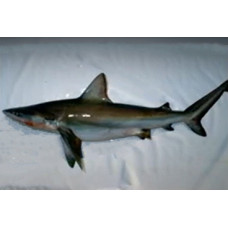Latin name
Carcharhinus altimus
Other names
Carcharhinus altimus
Identification
They have a heavy body with a relatively long, broad and blunt snout with pronounced nostril grooves. The eyes are rather large and round with a blinking membrane. The mouth is conspicuously curved with small furrows at the corners. There are five pairs of gill slits of moderate length. Oval scales in the form of skin denticles are close together but not overlapping, with skin visible between them. Each scale is covered with three horizontal grooves ending in denticles.
Teeth
On the upper jaw 14-16 rows of teeth on both sides, triangular, broad, with serrated edges, projecting vertically from the centre of the jaw and gradually sloping towards the edges. On the lower jaw 14-15 rows of teeth on both sides, teeth narrow, straight, with very fine serrations.
Features of fish fins
The pectoral fins are long and broad, with protruding tips and almost straight contours. The base of the first dorsal fin is approximately in line with the posterior part of the base of the pectoral fins, the dorsal fin is rather high, sickle-shaped, with a blunt tip and a long, unattached tip behind the base. The second dorsal fin is relatively large, also with a short free posterior tip, and is slightly anterior to the anal fin. A high ridge runs between the fins. There is a crescent-shaped notch at the base of the upper edge of the caudal peduncle. The caudal fin has a large lower lobe and a strong notch near the apex of the upper lobe.
Fish colouring
The colouration is grey with a bronze tinge, with a pale stripe down the sides, the belly is white; sometimes the gills are green. The tips of the fins (except the pelvic fins) are darker, most noticeable in juveniles.
Distribution
They are ubiquitous in tropical and subtropical waters. In the Atlantic they are found from Delaware Bay to Brazil, in the Mediterranean and off West Africa. In the Indian Ocean, they are found off South Africa and Madagascar, in the Red Sea, off India and the Maldives. In the Pacific they are found from China to Australia, around Hawaii and from the Gulf of California to Ecuador.
Habitat
They are found near the edge of the continental shelf and above the continental slope, close to the seabed at depths of 90-430 metres.
Size
The average length of males and females is 2.7 m and 2.8 m respectively, although individuals of this species can reach 3 m in length. The maximum body weight is 168 kg.
Behavior
Juvenile sharks can reach up to 25 m. These sharks are found close to the surface at night, suggesting that they are characterised by diurnal vertical migrations. Individual sharks have been recorded travelling distances of 1600 to 3200 km.
Food and feeding habits
They feed mainly on bony bottom-dwelling fish (lizard heads, humpbacks, flounders), cartilaginous fish (catrans, catsharks (Holohalaelurus), stingrays, chimaeras) and cephalopod molluscs.
Reproduction
Like other sharks of the genus, they are viviparous; after the embryo has exhausted its yolk supply, the empty yolk sac becomes the placenta, through which the mother provides nourishment to the embryo. There are 3 to 15 newborns in a litter, usually 7. Pregnancy lasts about 10 months. A female can be fertilised by two or more males. Births occur in August-September (in the Mediterranean) and September-October (in Madagascar). Newborns are 70-90 cm in length. Males and females reach sexual maturity at about 2.2 m and 2.3 m respectively. The average age of reproductively active individuals is 21 years.
Fishing
Fished in Cuban waters for the production of fish oil, leather and fish meal.
Relationship with a person
As they stay in deep water, they rarely come into contact with humans. In some regions, such as Southeast Asia, the meat of these sharks is eaten and the fins are exported for shark fin soup.
| Classification | |
| Phylum | Chordata |
| Class | Chondrichthyes |
| Squad | Carcharhiniformes |
| Family | Carcharhinidae |
| Genus | Carcharhinus |
| Species | C. altimus |
| Features | |
| Conservation status | Near Threatened |
| Habitat | Pelagic |
| Life span, years | No information |
| Maximum body weight, kg | 168 |
| Maximum length, cm | 300 |
| Sailing speed, m/s | No information |
| Threat to people | Edible |
| Way of eating | Predator |
Bignose shark
Tags: bignose shark

